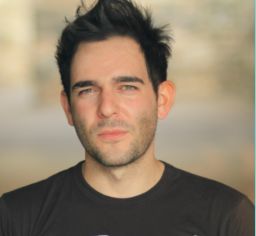Editor’s Note: Tess Taylor is the author of the poetry collections “Work & Days,” “The Forage House” and most recently, “Rift Zone” and “Last West: Roadsongs for Dorothea Lange.” Views expressed in this commentary are solely hers. Read more opinion articles on CNN.
Before the pandemic hit, playwright Matthew-Lee Erlbach was working on a play about American labor movements between 1890 and 1920 – an era that many associate with seamstresses jumping out of a burning factory during the Triangle Shirtwaist Fire, Upton Sinclair’s exposés of foul meat factory buildings or Mother Jones’ tireless organizing on behalf of mine workers.

While Erlbach was invigorated by his research and writing, he wasn’t expecting to start a labor movement of his own. But as the pandemic dragged on, throwing the theater world into disarray, that is exactly what he did.
Erlbach and his colleagues – actor Carson Elrod, actress Brooke Ishibashi and writer-director-performer Jenny Grace Makholm – founded Be An #ArtsHero, a full-time campaign devoted to lobbying Washington politicians to imagine an economic recovery that includes renewed and deepened investment in the arts. At the same time, they’re pushing for a sustained change in how we understand the role of artists and the arts in American life.

There’s no question that the pandemic has hit the arts world extremely hard. While many are industries reeling, the situation confronting facing the arts community is particularly dire. This future of art and artists in America matters. “What we are experiencing is an economic cataclysm,” Erlbach told poet and CNN contributor Tess Taylor. “The arts are not a luxury, they are an industry.” Erlbach and Taylor spoke by phone and zoom about his efforts to center the arts in national conversations about pandemic relief and repair.
This interview has been edited for clarity and flow.
Tess Taylor: So how did Be An #ArtsHero start?
Matthew-Lee Erlbach: It started out of a desperate need. In an instant last March, the entertainment industry went dark, our industry shut down – particularly anything that required large groups of people (Broadway, regional theatres, opera, dance, concerts, music festivals, museums production sets). We were the first to close and we’ll be the last to reopen. (According the Brookings Institution) 2.7 million arts and culture jobs evaporated virtually overnight. That’s millions of workers, billions of dollars and countless livelihoods that put food on the table, keep the lights on and pay for health insurance: gone.
Carson Elrod, Brooke Ishibashi and Jenny Grace Makholm had been doing incredible social media work and making a public push for Federal Pandemic Unemployment Compensation, a 100% COBRA subsidy, and an expansion of the Payment Protection Program. While that was happening, Brooke called me to tell me what she was doing; I loved what I heard and had been working on a letter of my own. A few weeks later, my Open Letter to the US Senate went viral and we all joined forces to get our Voltron on.
Since then, we’ve grown complementary departments: Grassroots organizing, lobbying, public policy and marketing. This is all to create a sustained national campaign to educate, organize and activate ourselves across disciplines, industry and region. Our goal is to make ourselves a legislative priority. Arts and culture workers are a major labor force. We’re talking over 5.1 million hard-working arts and culture workers generating nearly $878 billion in 2017 annually across 435 congressional districts, according to a report from the National Assembly of State Arts Agencies (NASAA). They prepare excellent reports which further characterize these numbers, as do findings from Americans for the Arts. These are jobs, that build more jobs. The arts is an economic driver. We are a jobs multiplier.
Taylor: Is it strange asking artists to consider themselves part of a labor movement?
Erlbach: Many artists are in unions like the Writers Guild of America, Screen Actors Guild and so on. In the theater, film, and TV there’s already a sense of “what we do is labor.” We are literal “companies” of people coming together to do the business of a play (a small business) or a TV series, which, if you’re fortunate, is a highly profitable small business of hundreds of employees, that runs for ten seasons. What the pandemic has revealed is that, since we are so intersectional, we are not stronger in the silos of our disciplines and regions.
As I said, the NASAA reports that there are 5.1 million arts and culture workers across disciplines and regions in the US, while the Brookings Institution’s seminal report, “LOST ART: Measuring COVID-19’s Devastating Impact on the Creative Economy,” written by Michael Seman and Richard Florida, puts the estimate at 8.8 million jobs, with sales of over $1.7 trillion, when you include other industries like fashion. These numbers are just cold, hard, data. Which proves that we are stronger when we come together, empowered by our economic and cultural value, unified in a legislative agenda. It is transformative. We are labor. Our work has dignity. And we must be made an economic and legislative priority.
Taylor: Your platform is also about systematic reinvestment in the arts as a way forward for America now.
Erlbach: Talking about economics is not to diminish the cultural, human and spiritual expression of what we do. But it is to say, if we want meaningful legislation passed, we must show how arts and culture-centered businesses are the blueprint for economic revival. Because when you plant a museum, theatre, concert venue or cultural space in an area, it’s only a matter of time before coffee shops and breweries grow. Retail. Restaurants. Real estate. And before you know it, tourism. Which is tax dollars. Which helps pay for schools. And community programs. And roads. And parks. And bridges. Which is jobs. And suddenly, that community is flourishing.
Arts and culture workers are bees. We will pollinate your community. Invest in us and you will get an outsized return. And honey. In short, our fates are tied together: there is no American economic recovery without a robust arts and culture economy recovery. We are one of America’s greatest resources and we are ready to help rebuild this nation.
Taylor: Tell me about the DAWN Act and why it matters now.
Erlbach: The DAWN (Defend Arts Workers Now) Act is about jobs, jobs, jobs. It is a dedicated economic relief and recovery for the human infrastructure of our sector. Which we need immediately. In short, this is an infrastructure bill that helps sustains jobs, creates jobs, cuts unemployment, and incentivizes investment, which will have a jobs-multiplier effect in our communities. DAWN would authorize $43.85 billion in increased funding to existing federal structures who will make direct grants to the small business owners and mixed-income earners in our sector. These agencies include the Small Business Administration, National Endowment for the Arts, National Endowment for the Humanities, Institute of Museum of Library Services and Corporation for Public Broadcasting, to make direct grants to the operators, employees and artists of live venues, recording venues, cultural spaces and arts-related businesses.
We need to put creative workers to work. And we need to do it fast. The DAWN Act is a blueprint in investing in America’s most precious resources: our ingenuity, our innovation, our creativity, our humanity, and our economic power. You can read more about our DAWN proposal here. We also support the visionary and jobs-centric “Putting Creative Workers to Work” proposal created by Americans for the Arts. We are ready to do the work for economic revival and national reconciliation.
Taylor: How does this effort compare to, say, the New Deal, which put American artists to work in so many places – the Farm Security Administration, for instance, or in oral history projects?
Erlbach: The New Deal was visionary in its thinking and execution. It was a public-private partnership that put Americans to work and rebuilt this nation’s infrastructure and identity. The full DAWN proposal is certainly shaped in a similar vein. Investing in public works projects that put visual artists, writers, set builders, engineers, technicians, arts admin, stagehands, designers, performers, teaching artists, arts educators, and our entire industry to work will also jumpstart arts-adjacent industries. We must embrace America’s creative workers to beautify our spaces, tell our stories, rebuild our communities for our communities, and imagine a new century. This is not just a new deal – this is a new promise.
Taylor: One of the Be An #ArtsHero long-term goals is to create a Department and Secretary of Arts and Culture, or what you called a “Dr. Fauci” for the Arts. How would this person aid in American economic recovery?
Erlbach: The United States Department of Arts & Culture would be a cabinet-level department responsible for overseeing the implementation of locally-based, regionally-driven comprehensive economic development strategies, centered on the creative economy and Arts & Culture workers in public-private partnerships. For instance, the Department of Arts & Culture, in coordination with existing arts agencies, could work with governors, mayors, municipal leaders, and state and local arts agencies to incentivize creative worker jobs in infrastructure, public works initiatives, prisons, veterans’ affairs, education, mental health and so on.
We’re already doing this work in all these areas and then some – our country needs to embrace creative solutions to the outstanding economic, social, racial, and geographic challenges we face. Having a partner at the federal level would transform our relationship to the role Arts & Culture plays in the story of America – but also our outsized economic performance. We’ve got to have a fighter in DC looking out for our sector. Figures from the Bureau of Economic Analysis state that the creative economy makes up 4.5% of our GDP – more than agriculture and mining combined. If you want to protect economic prosperity, you must give us a seat at the legislative table to work with the states. The return on investment is extraordinary in economic terms but also in human terms.
Taylor: What’s been the most unexpected part of this journey?
Erlbach: The whole journey. When the pandemic hit, I was writing for a show called “We Are the Champions” with Rainn Wilson on Netflix – if you want to learn about competitive cheese rolling and dog dancing, I highly recommend. We were top 10 on Netflix. Hats off to Dirty Robber, who produced. So, no, I didn’t think I would be creating economic impact/loss reports for Senators and House members before meeting with their teams. And I certainly didn’t think I’d be writing a bill.
But the most unexpected part of this journey has also been the most gratifying: connecting with my fellow arts and culture workers, joining the call to make our intellectual, creative and physical labor a legislative priority and a cornerstone of America’s recovery. Really, the most unexpected part of this journey has been building community across the aisle and across the country. And seeing Amanda Gorman perform her beautiful words really sum up this moment best for me in this moment: “the new dawn blooms as we free it. For there is always light, if only we’re brave enough to see it. If only we’re brave enough to be it.”



